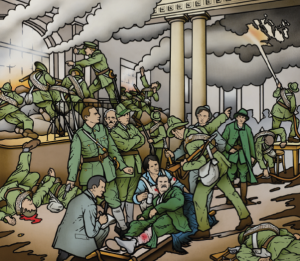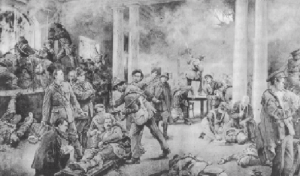Paget’s Birth of the Irish Republic re-imagined
Published in 18th–19th - Century History, Features, Issue 5 (September/October 2013), Volume 21
Above: Robert Ballagh’s reinterpretation of Walter Paget’s Birth of the Irish Republic and (opposite page) the original. (National Museum of Ireland)
The first monument erected by the National Graves Association was over the graves of rank-and-file Easter Week Volunteers in Glasnevin Cemetery. It was unveiled by Frank Ryan on 31 March 1929. Over the years the monument began to show signs of wear and tear, so on the 50th anniversary of the Rising the association, at considerable cost, replaced it with the present memorial, which consists of seven concrete standing columns more than 5m high. The passage of time and inclement weather have not been kind to the memorial; the concrete columns have become discoloured, and the paving slabs and surrounding steps have seriously deteriorated. The NGA has come to the conclusion that, as we approach the centenary of the Rising, this memorial will have to be refurbished. Plans have been drawn up for this ambitious project, which include cladding the columns with granite and reinstating the paving and steps.
The total cost of the refurbishment will be over €150,000, which the NGA has undertaken to raise in appreciation of the sacrifice that these brave heroes made in the fight for Irish freedom. Obviously the raising of such a sum represents an enormous task, so the association asked me (and many others) for fund-raising ideas. After some thought, I came up with the idea of producing a limited-edition print.
That was the easy part; deciding what image to use proved much more difficult. In struggling to come up with an idea I found my mind drifting back to paintings that I made many years ago in response to the conflict in the North. Looking for inspiration, I ploughed through many art history books before eventually coming across several iconic paintings where it seemed to me the artists of the past had dealt with issues of their time that were not dissimilar to the unfolding violence in the North of Ireland. At the time I chose to re-imagine images like Goya’s The third of May and Delacroix’s Liberty at the barricades in a Pop Art style that I hoped would communicate the power of the originals to a modern audience. That approach struck me as the way to go as far as the Glasnevin project was concerned—except, as far as I know, there are no iconic paintings of recent Irish history in existence.
 Then, from the dim and distant past, I remembered a black-and-white image portraying the inside of the GPO during the Easter Rising that in those days was reproduced in school books and sometimes displayed as a poster on school walls. But when I went looking for a clean reproduction of the work I had no luck. It seemed to have disappeared from sight and from memory. Eventually the National Museum came to my rescue with a fine black-and-white photograph, which I used to create my own version of the original.
Then, from the dim and distant past, I remembered a black-and-white image portraying the inside of the GPO during the Easter Rising that in those days was reproduced in school books and sometimes displayed as a poster on school walls. But when I went looking for a clean reproduction of the work I had no luck. It seemed to have disappeared from sight and from memory. Eventually the National Museum came to my rescue with a fine black-and-white photograph, which I used to create my own version of the original.
The first change I made was to introduce colour, and then I decided to alter the composition so that the focus of the picture would underscore the importance of the leaders of the Rising. When I was working on my version, all I knew about the original was that an English artist called Walter Paget had created it and that its title was Birth of the Irish Republic. Once I was finished, however, and the limited edition was produced and put on sale, people kept asking for extra information. I decided that I had better do some research [see sidebar].
The original artwork had been bought by the National Museum from a Mrs Kiersy of Monkstown, Co. Dublin. This information suggests that the motivation for its creation was not an official commission. Having learned that Mrs Kiersy was a widow and that her husband had been a printer, I am willing to postulate that Mr Kiersy had commissioned the artist to create the image in order to publish a commemorative poster. The Museum’s catalogue number for the artwork is EW23 (‘EW’ for ‘Easter Week’), which suggests that it entered the Museum’s collection at an early date after the Rising. Another interesting piece of information is contained in a letter written by a Father Twohig of Cork, the author of several books, including one on the death of Michael Collins. In his letter he suggests that the painter Jack B. Yeats was a friend of Walter Paget and that he helped him by providing background information, photographs and other relevant items. Whatever the truth about the creation of the original, I hope that the print of my interpretation of that iconic image will raise sufficient funds to ensure that the monument in Glasnevin is restored with the dignity and respect it deserves in time for the centenary of the Easter Rising.
Enquiries: National Graves Association, PO Box 7105, Dublin 2, www.nga.ie, +353 (0)87 6202680. HI
Robert Ballagh is an artist and president of the Ireland Institute, 27 Pearse Street, birthplace of Patrick Pearse.
Read More: National Graves Association
The brothers Paget
















